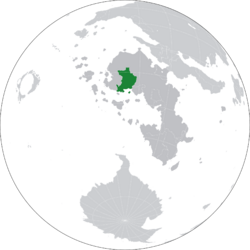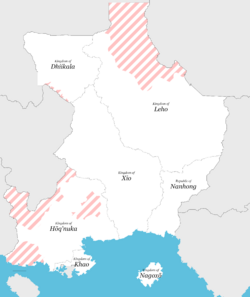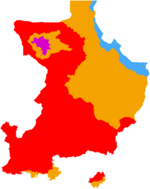Great Xio
Empire of Great Xio Nα Cıoⱶᾱɴϵ | |
|---|---|
|
Flag | |
 The Empire of Great Xio (dark green) in Aurelia (dark grey) | |
| Capital | Pashae |
| Largest city | Xiseka |
| Official languages | Xi Dialect |
| Recognised national languages | Le Dialect, Nūqa, Ka Dialect, Huang |
| Recognised regional languages | Soho, Naho, Medhiatei |
| Ethnic groups (2021) | Xieika, Hong, Leika, Nuthan, Kaika, Nahaika, Huang, Garindinan, Rhodellian, Yuzhstovan, Ateenian, Sohoika, Medhiati |
| Demonym(s) | Xioan |
| Government | Federal Theocracy |
• Mountain Lord | 77th Vosō Ne |
• Elected Grand Syndic | Pakheō-voke Hisema |
• Emperor Absentia | Aidan Redmond |
| Legislature | Imperial Government & Syndic Council |
| Establishment | |
• Xisekan Empire | 430 AD |
• Xi Kingdom | 927 AD |
• Empire of Great Xio | 1731 AD |
| Area | |
• | 784,000 km2 (303,000 sq mi) |
| Population | |
• 2021 census | 8,829,200 |
| GDP (PPP) | 2021 estimate |
• Total | 31,564,390,000 |
• Per capita | 3,575 |
| GDP (nominal) | 2021 estimate |
• Total | 18,541,320,000 |
• Per capita | 2100 |
| Currency | Auro (𐠓) |
| Time zone | UTC-4.30 (ALT) |
| Date format | YY/MM/DD |
| Driving side | right |
This article is incomplete because it is pending further input from participants, or it is a work-in-progress by one author. Please comment on this article's talk page to share your input, comments and questions. Note: To contribute to this article, you may need to seek help from the author(s) of this page. |
Great Xio (Xi: Nα Cıoⱶᾱɴϵ, Na Xiohane) officially The Xiohane, the Empire of Great Xio, or informally as Xio, is a developing country on the continent of Aurelia bordering Sefesia to the southeast, Proncawi'chi to the northeast, Nuthahan to the west, and the Seylosian city state of Kaseka to the south. The nation is primarily within the western Aurelian Wastes with its borders extending into the Auriel Gulf by the Nagaxō island. The total land area of Great Xio is 784,000km2 with an estimated 2021 population of more than 8.8 million people.
Great Xio is a federal parliamentary anocracy with the head of state, the Mountain Lord, possessing great executive power and the ability to override Imperial Government rule up to and including the removal of the current head of government, the Grand Syndic, from office at any time. The current Mountain Lord, known previously as Rahāde Deyakho-Xae and the middle child of the previous Mountain Lord, was elected to his position on the 17 March 2021. Great Xio's constitution still acknowledges the existence of an emperor, however since the title being sold to Seylos in 17XX the title was renamed to Emperor Absentia (Absent Emperor) with the emperor holding no power in government. The current emperor of Great Xio is Aidan Redmond, the king of Seylos since the 29 June 2018.
Inhabited since the first migratory peoples of Aurelia (55kya), the lands that make up Great Xio have seen numerous waves of migratory and colonising people groups resulting in unique phenotypical appearances for numerous Syrbotae groups that inhabit Great Xio and the wider Syrbotae Aurelian Wastes. With the arrival of the Medhiati Aromans, the original Nuthan city states were wiped out through disease and warfare, allowing for the migration of the Syrbotic groups from Dhiikala south into the Xi river valleys and the eventual establishment of the Xi and Le empires. Seeing threats from colonial powers throughout the 1400s and 1500s, Great Xio was able to maintain independence through careful political balancing of colonial powers and immunity to non-Aurelian diseases preventing cascading population loss. The modern Great Xio empire rose in the 1720s and 1730s with the consolidation of guilds, tribes, and city states into a cohesive federal state and later expanded through the successive annexation of its neighbouring states. In the 1970s border conflicts with Sefesia almost led to war however cooler heads prevailed. In 2012 the annexation of Nagaxō sparked international outrage with Great Xio almost being cut off from the Aurelian League until the establishment of the Autonomous Regency of Nagaxō under the Empire of Great Xio.
Great Xio is a founding member of numerous organisations including the Aurelian League, the League of Alharu and Aurelian Native Nations, and the Aluminium Production and Consumption Association. Great Xio enjoys a comfortable geopolitical position despite the instability of its neighbours often spilling into its own borders and continual political threats from Sefesia.
Etymology
Xio /ʃiɁo/ (Cıo) comes from old Xi-Le sixeho which means “land of the Si people”. The Si people, before migrating into their modern day homeland, were a collection of pastoralised goat herding tribes who lived on the Transwananga Plateau north of the Dhiikala mountains since the Aurelian Archaic Period. They lived primarily in the area now known as Sewu on the southern boundary of the Wananga mountains on modern Great Xio's northernmost border.
The etymology of the people name “Si” is contested. The most popular suggestions are that it derives from the Old Wananga term /sjɪ/ meaning goat horn, or from Old Syrbotae /sɨ/ for rope or knot.
The first known usage of the term Sixeho comes from some of the oldest surviving documents of the Syrbotic Faith in the Dhiikala mountains in the early 7th century. It was used as a term denoting the lands between the Aroman settler cities and the Dhiikala mountains. The term eventually ground down to “xio” where it was recontextualised with the rise of the maritime city of Xiseka (“City of the south”) to mean “land of the south(ern) people”.
Xiohane (Cıoⱶαɴϵ) literally translates to “larger Xio”. In Anglish Great Xio is rarely pronounced /ʃiɁohane/ in official capacity despite it being the formal name of the country with /ʃioheɪn/ or /ʃio/ preferred.
The common Ilene/Anglo poetic name for Great Xio - Internecios Syrbotium - has its roots in the 16th century. Its first recorded use was in the Syrbotichronicon to describe the lands of northern Aurelia at the time of the migration by the Syrbotic people into the Aurelian Empire in the 6th century. The subsequent destruction of cities that forced the Aurelian Empire to abandon northern Aurelia in the early 7th Century:
“Oh the fallen lands of north Aurelia, now the internecios Syrbotium has arisen from its ashes. Its massacres and destruction of wonderous urban landscapes did not fill its stomach, as the corpses of cities were corrupted by the eurth of Syrbotium. One corpse was Sollonia which was corrupted and henceforth called the city of Xiseka from which this current so-called empire takes its name […] the internecion of Xiseka across the Auriel Shield but a taste of the blood-saturated lands of Syrbotium it had come from.”
The poetic name saw little use throughout the centuries, outside of poetry and recounts of the Syrbotichronicon until the Second Aurelian War where the high death rate battlefields of Hōq'nuka and Xiseka were used in Kirvinan Anti-Mito propaganda. This propaganda described Great Xio as the Internecios Syrbotium alongside Xisekan imagery. In the present day, the poetic name is usually shortened to Syrbotium when used in literature and poetry. The word Syrbotium is derived from the exonym Syrbotae used for the indigenous peoples of the Western Wastes. The first ever record of the term Syrbotae was by Lucius Plinius Rimor, in his encyclopaedia Occidentis historia (Western History). In this work, he named the people who lived in the western deserts the Syrbotae.
Geography
The Empire of Great Xio is entirely within the desert of the Aurelian Wastes with only the north east of the nation within the Aurelian steppes. The vast majority of the population lives alongside the main rivers in southern Great Xio, making up around 80% of the population, with smaller populations in the desert canyons of Hōq'nuka, the steppe shrublands of Leho, or the mountain valleys of Dhiikala.
WIP
History
WIP
Nuthan City States (Before 300 AD)
WIP
• Nuthan coastal and river city states.
Aroman Settlers (300 AD-500 AD)
WIP
• Nuthan city states disappear as Nuthans are killed off from disease and from Aroman colonists.
Syrbotic Southern Migration (500 AD)
WIP
• Syrbotic groups migrate south into modern day Xio spreading the Syrbotic Faith
• Mix with the smaller number of Aroman settlers to form the beginning of Syrbotae civilisation. Aroman as a cohesive group ceases to exist on the mainland by the mid 7th century.
Xiseka Mercantile Domination (700 AD-1000 AD)
WIP
• Xiseka takes over the Aurelian Empire's northern provinces
Reintegrated into Aurelia (1000 AD-1500 AD)
WIP
• Leho invaders destabilises region.
Syrbotic Guild Confederacies (1500 AD - 1700 AD)
WIP
• Xio Kingdom plays off Mito and Aurelia and gains independence.
• Guild system from Mito late 1500s / early 1600s.
• Consolidation of tribes and city states into guilds.
• Leho temporarily rises as a power in the region but falls at the turn of the century in 1700 AD.
Creation of the Empire of Great Xio (1700 AD-1730 AD)
WIP
• Previous empires and kingdoms could not achieve the same size as the modern Great Xio due to the unconsolidated tribes and city states. Xiseka was the exception as it was a maritime empire, not a terrestrial one like its descendants. Annexation of Late Hōq'nuk, Khao, and Dhiikala the start of the empire.
Early Modern Period (Mid 16th Century-19th Century)
WIP
• Yellow Empire colonisation on Nanhong
• Seylosian petty lords establishment of the coastal city colonies, including Kaseka.
• Seylosian navy forces Yellow Empire to stop expanding its colony to both protect the empire and for its own self interests.
• Xio sells emperor title to Seylos as both a thanks to Seylos for stopping the Yellow Empire but also to end the reign of emperors within Xio.
• Mountain Lord consolidates power, becoming the undisputed head of the empire. Seylosian city states along the coast begin to be picked off. Kaseka only one left as the largest and oldest Seylosian colony.
• Mid 1800s Leho annexed.
Contemporary Period (1900-Present)
WIP
• 1902, contemporary period marked by the introduction of Guild-based representational democracy and the creation of the HoG Grand Syndic title.
• Late 1910 Nanhong falls into debt, sells itself to Great Xio after Fulgistan becomes socialist.
• 1920, Great Xio divides its lands into federal states in the form of the modern day kingdoms and republic of Great Xio.
• Founding member of the Aurelian League at the end of the Second Aurelian War
• Border conflicts with Sefesia in mid 1900s.
• 2012 annexation of Nagoxō.
• 2022 90 Day Purge - 236 Syndics removed
Politics
The Empire of Great Xio is divided into 7 dominions of differing autonomy.
| # | Name | Type | Population | Guilds | Flag |
|---|---|---|---|---|---|
| 1 | Xio | Kingdom | 4,326,308 | 1240 | 
|
| 2 | Leho | Kingdom | 1,147,796 | 327 | WIP |
| 3 | Dhiikala | Oligarchic Theocracy | 176,584 | 50 | WIP |
| 4 | Hōq'nuka | Kingdom | 618,044 | 176 | WIP |
| 5 | Khao | Kingdom | 441,460 | 126 | WIP |
| 6 | Nanhong | Republic | 1,854,132 | 529 | WIP |
| 7 | Nagaxō | Autonomous Regency | 264,876 | 75 | 
|
WIP
National Government
WIP
State Governments
WIP
Guild Communes
WIP
Policy
WIP
Economy
WIP
Mining
WIP
• Aluminium and titanium mining.
• Slavery controversy.
Agriculture
WIP
• Goat herding.
• Subsistence farming.
• Growing export-based steppe farming economy.
Tourism
WIP
• Kaseka
• Nanhong
• Xiseka
Manufacturing
WIP
• Small growing manufacturing industry in urban areas.
Demographics
WIP
Ethnic Groups
WIP
Education
WIP
Language
First textual references to the Syrbotic languages comes in the early 5th century as oldest known uses of the Laimiaic Alphabet being used for transcribing the Xi-Le Language were uncovered in some of the oldest surviving crypts in Xiseka alongside the surviving documents in modern day Dhiikala of the Syrbotic Faith around the same time period. Both sets of documents use very similar orthography, which has led archaeologists and historians to theorise that the lands controlled by the Xi-Le may have been under a single political entity after the fall of the Aurelian Empire in the north and before the rise of the city of Xiseka. Thus far only linguistic evidence of this political entity exists with the loanword of 'hane/han' in many western and northern Aurelian languages used to mean 'large' or 'empire' may have come from this lost political entity, and possible reference in the Syrbotic Faith scriptures to a 'tyrannical force that surrounded the first enlightened village'. However, mainstream interpretation of the quote by both the common practitioners, the priesthoods, and historians is that the 'tyrannical force' was in reference to neighbouring villages and not a pre-Xisekan empire.
The modern day area of Great Xio is host to numerous different languages, however many of the Syrbotic languages are considered either dialects of the capital Xi dialect (known in linguistics as either the Xi-Le Language or Interior Syrbotic) or the remnants of the old Xisekan language which still survives as several distinct dialects along the coastline of Great Xio, Kaseka, and the islands of Nagaxō (known as either the Ka-Na Language or Maritime Syrbotic). Other languages in the empire, such as Huang and Nūqa make up the majority within their respective dominions (Nanhong and Hōq'nuka).
The smallest recognised language in the empire is the critically endangered Medhiatei within the interior of the island of Nagaxō with an estimated 300 speakers split between 5 villages. Currently the Autonomous regency of Nagaxō has made agreements with the Medhiati People to introduce Medhiatei into the national curriculum of the island, though there are no plans to have it introduced as an OL subject in the imperial curriculum.
Health
WIP
Religion
WIP
Holidays
WIP
Culture
WIP
• Incredibly strong pro property & land rights culture, yet property rights to families and guilds not individuals.
Gender and Sexuality
WIP
Forbidden Names
WIP
Tattoos
WIP
Art and Literature
WIP
• Work-arounds for not showing faces of the deceased.
Philosophy
WIP



